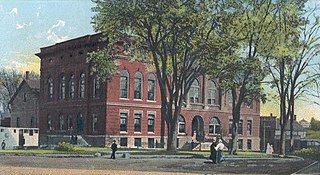
Waterville is a city in Kennebec County, Maine, United States, on the west bank of the Kennebec River. The city is home to Colby College, Thomas College, and the headquarters of HealthReach Community Health Centers. As of the 2020 census the population was 15,828. Along with Augusta, Waterville is one of the principal cities of the Augusta-Waterville, ME Micropolitan Statistical Area.

The Gov. George S. Boutwell House is a historic house at 172 Main Street in Groton, Massachusetts, USA, that was home to Governor George S. Boutwell. It was built in 1851 and added to the National Register of Historic Places in 2005. It is the current headquarters of the Groton Historical Society.

The Universalist Unitarian Church is a historic church on Silver Street and Elm Street in Waterville, Maine in the United States. Built in 1832 for a Universalist congregation founded in 1826, it is a prominent local example of transitional Federal-Gothic Revival architecture. It was listed on the National Register of Historic Places in 1978.
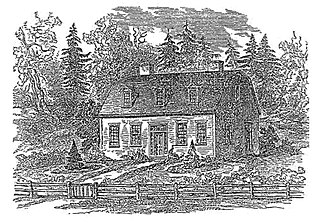
St. John's Anglican Church and Parsonage Site is an historic religious site in Dresden, Maine. It is the site of an Anglican church built in 1770 in what was then called Pownalborough or Frankfort, and was active until 1779. The church congregation was founded in 1760, and the church and parsonage were built with funding support from Dr. Silvester Gardiner, a major area landowner, and operated until 1779, when Jacob Bailey, the minister, fled the area because of his Loyalist views in the American Revolution. The site was listed on the National Register of Historic Places in 1978.

The Wiscasset Jail and Museum is a historic jail on at 133 Federal Street in Wiscasset, Maine. Built in 1811, it is one Maine's oldest surviving jail buildings, serving as the state's first penitentiary between 1820 and 1824. It is now a museum operated by the Lincoln County Historical Society as the 1811 Lincoln County Museum and Old Jail. It was listed on the National Register of Historic Places in 1970.

The Pownalborough Courthouse is a historic court house at 23 Courthouse Road in Dresden, Maine, USA. Built in the early 1760s, it was the first county courthouse for Lincoln County, which was established in 1760. It is the only surviving courthouse in the state of Maine that was built during the colonial period, and is now a museum owned and operated by the Lincoln County Historical Society. It was listed on the National Register of Historic Places in 1970.

The Islesford Historical Museum and Blue Duck Ships' Store are related historical exhibits on Little Cranberry Island in Maine, USA, within the boundaries of Acadia National Park.

Maine Maritime Museum, formerly the Bath Marine Museum, offers some exhibits about Maine's maritime heritage, culture and the role Maine has played in regional and global maritime activities. Maine Maritime Museum has a large and diverse collection, made up of millions of documents, artifacts and pieces of artwork and includes an extensive research library.

The Moses Hutchins House, also known as the Kimball-Stanford House, is a historic house at the junction of Old Stage Road and Maine State Route 6 in Lovell, Maine. Built c. 1839, this two story wood-frame house and attached barn have retained their Federal period styling, while exhibiting the adaptive alteration of early farmsteads over time. The house was listed on the National Register of Historic Places in 2003.
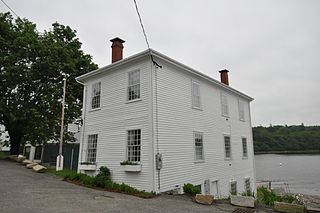
The Gates House is a historic house museum at 344 Port Road in Machiasport, Maine. Built in 1807, it is a remarkably high-quality Federal period house built in what was then a frontier area. The house is now owned by the Machiasport Historical Society, which uses it as its headquarters and museum. It was listed on the National Register of Historic Places in 1975.
The Martin Kinsley House is a historic house at 83 Main Road South in the Hampden Highlands village of Hampden, Maine. Built about 1797, it is a well-preserved example of modest Federal period architecture. It is further notable as the home of Martin Kinsley, a prominent local politician who served in the United States Congress. The house, now the museum and headquarters of the Hampden Historical Society, was listed on the National Register of Historic Places in 1983.
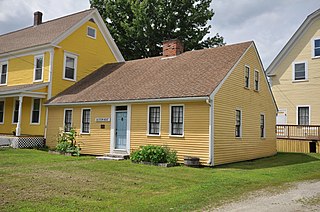
The Blossom House is a historic house museum on Main Street in Monmouth, Maine. Built about 1808, it is a well-preserved example of a Federal period Cape style house. It was listed on the National Register of Historic Places in 1989, and now serves as a museum for the local historical society.

The Foster-Redington House is a historic house at 8 Park Place in Waterville, Maine. Built in 1883, it is a fine example of Queen Anne architecture, supposedly the city's first example of the style. It was built by Moses Coburn Foster, a well-known builder in the state, as his private residence. Moses owned M.C. Foster & Son, general contractors and builders. An advertisement for the business lists its location as 7 Park Place, which was the home built for his son, Herbert Foster. Herbert died at 38 years old. Herbert's home is as unique as Moses' but has not been restored, but instead, turned into two apartments.
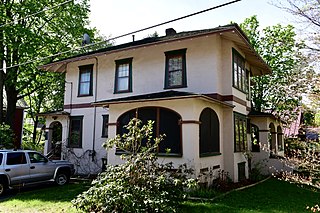
The Heald House is a historic house at 19 West Street in Waterville, Maine. Built in 1916 to a design by Herbert E. Knapp, it is the city's only substantial example of Prairie School architecture. It was listed on the National Register of Historic Places in 2005.

The Old Waterville High School, also known historically as the Gilman Street School, is a former school building at 21 Gilman Street in Waterville, Maine. Opened in 1912 and enlarged in the 1930s with Works Progress Administration funding, it is locally distinctive for its Collegiate Gothic and Art Deco architecture, and for its importance to the city's education system. The building, now converted to residences, was listed on the National Register of Historic Places in 2010.

The Waterville Opera House and City Hall is a historic civic building at Castonguay Square in downtown Waterville, Maine. Built at the turn of the 20th century, it is one of a small number of multifunction civic buildings, housing both a live performance venue and municipal facilities, functions it continues to perform today. It was listed on the National Register of Historic Places in 1976.

The Old Waterville Post Office is a historic post office facility at 1 Post Office Square in central Waterville, Maine. Built in 1911, it is a fine local example of institutional Greek Revival architecture. It was listed on the National Register of Historic Places in 1977, and presently houses a restaurant and brewpub.

The Wayne Town House is a historic town hall on Maine State Route 133 in Wayne, Maine. Built in 1840, it is one of the state's little-altered examples of a period town hall building, retaining a number of distinctive features, including benches for sex-segregated seating. It was listed on the National Register of Historic Places in 1976.

The Waterville Main Street Historic District encompasses the best-preserved portions of the historical commercial downtown area of Waterville, Maine. Developed most intensively in the late 19th and early 20th centuries, this area was the center of commerce for Waterville and the surrounding rural communities. It encompasses 25 properties on Main and Common Streets, including the Waterville Opera House and City Hall. It was listed on the National Register of Historic Places in 2012, and was slightly enlarged in 2016.

The John Williams House is a historic house located on Pond Road in Mount Vernon, Maine. Built in 1827, this modest Cape is regarded for its high quality interior woodwork, and well-preserved stencilwork attributed to folk artist Moses Eaton. The house was listed on the National Register of Historic Places on December 6, 1984.




















